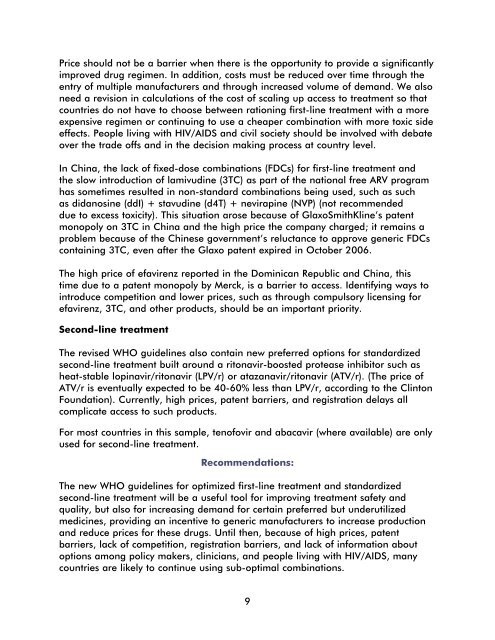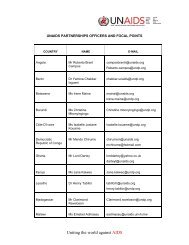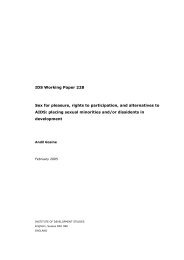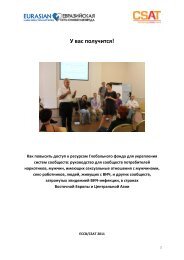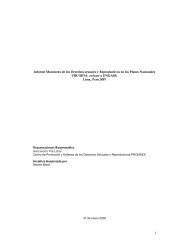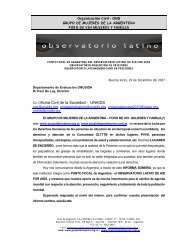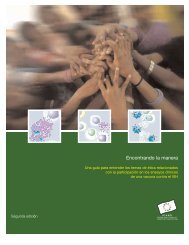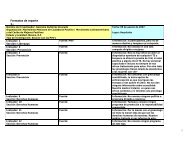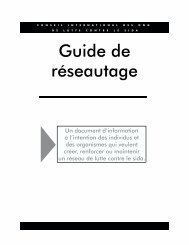Missing the Target #5: Improving AIDS Drug Access ... - CD8 T cells
Missing the Target #5: Improving AIDS Drug Access ... - CD8 T cells
Missing the Target #5: Improving AIDS Drug Access ... - CD8 T cells
You also want an ePaper? Increase the reach of your titles
YUMPU automatically turns print PDFs into web optimized ePapers that Google loves.
Price should not be a barrier when <strong>the</strong>re is <strong>the</strong> opportunity to provide a significantlyimproved drug regimen. In addition, costs must be reduced over time through <strong>the</strong>entry of multiple manufacturers and through increased volume of demand. We alsoneed a revision in calculations of <strong>the</strong> cost of scaling up access to treatment so thatcountries do not have to choose between rationing first-line treatment with a moreexpensive regimen or continuing to use a cheaper combination with more toxic sideeffects. People living with HIV/<strong>AIDS</strong> and civil society should be involved with debateover <strong>the</strong> trade offs and in <strong>the</strong> decision making process at country level.In China, <strong>the</strong> lack of fixed-dose combinations (FDCs) for first-line treatment and<strong>the</strong> slow introduction of lamivudine (3TC) as part of <strong>the</strong> national free ARV programhas sometimes resulted in non-standard combinations being used, such as suchas didanosine (ddI) + stavudine (d4T) + nevirapine (NVP) (not recommendeddue to excess toxicity). This situation arose because of GlaxoSmithKline’s patentmonopoly on 3TC in China and <strong>the</strong> high price <strong>the</strong> company charged; it remains aproblem because of <strong>the</strong> Chinese government’s reluctance to approve generic FDCscontaining 3TC, even after <strong>the</strong> Glaxo patent expired in October 2006.The high price of efavirenz reported in <strong>the</strong> Dominican Republic and China, thistime due to a patent monopoly by Merck, is a barrier to access. Identifying ways tointroduce competition and lower prices, such as through compulsory licensing forefavirenz, 3TC, and o<strong>the</strong>r products, should be an important priority.Second-line treatmentThe revised WHO guidelines also contain new preferred options for standardizedsecond-line treatment built around a ritonavir-boosted protease inhibitor such asheat-stable lopinavir/ritonavir (LPV/r) or atazanavir/ritonavir (ATV/r). (The price ofATV/r is eventually expected to be 40-60% less than LPV/r, according to <strong>the</strong> ClintonFoundation). Currently, high prices, patent barriers, and registration delays allcomplicate access to such products.For most countries in this sample, tenofovir and abacavir (where available) are onlyused for second-line treatment.Recommendations:The new WHO guidelines for optimized first-line treatment and standardizedsecond-line treatment will be a useful tool for improving treatment safety andquality, but also for increasing demand for certain preferred but underutilizedmedicines, providing an incentive to generic manufacturers to increase productionand reduce prices for <strong>the</strong>se drugs. Until <strong>the</strong>n, because of high prices, patentbarriers, lack of competition, registration barriers, and lack of information aboutoptions among policy makers, clinicians, and people living with HIV/<strong>AIDS</strong>, manycountries are likely to continue using sub-optimal combinations.9


